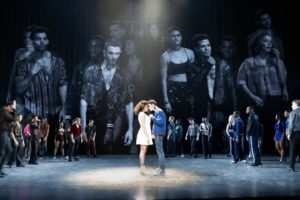Ivo van Hove and Anne Teresa De Keersmaeker / West Side Story - Vancouver Ballet Society
- Home
- Reviews 2020 - 2023
- Ivo van Hove and Anne Teresa De Keersmaeker / West Side Story

Depictions of violence are a specialty of Belgian director Ivo van Hove, served up once more in the recently opened West Side Story revival at New York’s Broadway Theatre. Video footage of blood spurting from switchblade wounds, pointblank shootings and close-ups of a sexual assault are projected on a giant screen that looms over the bare stage, images that make literal points in documentary fashion, bleak and terrifying.
In contrast to Jerome Robbins’ high-octane 1957 original staging, the film footage feels leaden. Fuelled by Leonard Bernstein’s taut, restless score, Robbins conjured up the horror of gang warfare in a chilling, stylized dance vocabulary of explosive leaps, space-chomping chassés and ominous finger-snapping. But in a first for U.S. audiences, van Hove ditched Robbins’ iconic handiwork in favour of the minimalist aesthetic of Belgian choreographer Anne Teresa De Keersmaeker.
There is a punk, starkly uncompromising attitude to De Keersmaeker’s work that matches the grimness of van Hove’s vision and finds beauty in moments of raw emotion. Jagged movements, grounded in modern, hip hop and martial arts give the dance and the fighting a modern-day immediacy, aided by streetwear and tattoos. While Robbins’ warriors frequently scaled great heights, their slashing limbs tracing big arcs through the air, De Keersmaeker’s are fighting a ground war.

Mixed-race casting downplays the whites versus Latinx immigrants theme, though it remains inescapable in the script’s references to Puerto Rico and in the accents of the Sharks and Jets. West Side Story’s greatest weakness, often amplified by casting misfires, is its crude stereotyping of Puerto Ricans. Although the occasional biting lyric by Stephen Sondheim (“Nobody knows in America / Puerto Rico’s in America”), takes aim at the Fox News-watching crowd as well.
Van Hove and De Keersmaeker made it hard for us to visually distinguish the Sharks from the Jets. Instead the somewhat trite narrative about a forbidden romance between two teenagers from rival immigrant clans has been spun into an allegory of outsiders. Isaac Powell and Shereen Pimentel give captivating performances as the impetuous Tony and Maria, but their individual identities feel less consequential in this production: they are stand-ins for a generation of young people from a mestizaje (mixed race) world whom society has marginalized.
A supercharged, rain-drenched rumble between the Sharks and the Jets is followed by an elegiac scene in which the ensemble rise slowly from the carnage, as if emerging from a coma. They assemble in pairs, heterosexual and same-sex, here a threesome, there a handful of loners. Rain-soaked and shell-shocked, they envelop each other in tender, sometimes erotic, grapplings; they seek shelter in each other and together sing pensively of how “there’s a place for us / somewhere.”
Refashioning Sondheim’s “Somewhere” into a universal plea for acceptance and belonging, van Hove and De Keersmaeker have extracted spellbinding new meaning from iconic material. And they do it with very little tech apart from ghostly stage lighting and a lot of water onstage.
Elsewhere, technology runs rampant — often to hair-raising effect. Designs which integrate boxy little sets-within-a-set, illuminated from within by hidden cameras, evoke the claustrophobia of life in public housing projects. B-roll showed actors negotiating the mean streets of Bushwick and gang members engaged in solo rituals in the run-up to rumbles. Gang members whip out smartphones to record a tense encounter with Officer Krupke, forcing him to holster his gun.

Close-up footage of the actors was effective during many dramatic scenes, but when dancing erupted, the video projections literally flattened it. Broadway performers are trained to dance “big,” but to have them compete with giant images of themselves projected on a screen felt like we’d suddenly tuned in to a reality TV dance competition.
That we stayed riveted was down to the electrifying dancers — notably Amar Ramasar as Bernardo, the truculent leader of the Sharks, Yesenia Ayala as his feisty girlfriend Anita and Dharon E. Jones as Riff, the smoothly contemptuous leader of the Jets.
When we watch performers on stage, we’d rather not have to contemplate their misdeeds IRL. In the case of Ramasar — one of three dancers fired from New York City Ballet last year for exchanging sexually explicit photographs of women in the company — it’s hard to do that. Ramasar was ultimately reinstated after the case went to arbitration. Yet protests outside the theatre and on social media serve as a reminder of the power of the #MeToo movement and force us to confront the question of whether someone who has been called out for behaving badly, and who has expressed remorse, deserves a second chance at a career. West Side Story producers think Ramasar does; nevertheless, they courted controversy by casting him as the coarse, swaggering leader of the Sharks.
Onstage misogyny was amplified in the gratuitous scene in which the Jets attempt to rape Anita. Playwright Arthur Laurents contrived this racially driven assault to provoke Anita into concocting a vicious lie that would crush Tony. Most reasonable audiences would conclude that she had ample cause to despise and double-cross Tony — after all, he had just killed her boyfriend! But Van Hove chose to play up the assault so that it became a pivotal plot point, dialled up the brutality, filmed it live in close up and projected it above the live action.
Once upon a time, activist artists believed they needed to heighten the horror of the violence in our society to force us to confront it and find more peaceful ways to coexist. Scientists have long since demonstrated that violence begets violence. Pity that Van Hove didn’t use his singular imagination to free us from the atrocity of another rape, just as he unleashed the heavens on the rumble, bringing on pelting rain to wash away fear and hatred.
Days after I watched the show, Broadway went dark in the war against COVID-19. New York City has become the new ground zero in a conflict we are woefully unprepared to fight, leadership at the highest levels paralyzed by vanity and pettifoggery. As fear and chaos descend, New Yorkers are looking to local leaders to restore order and instil hope. “A gang that don’t own a street is nuthin’,” exclaims a Jet in West Side Story. Let’s hope these fearless Jets and Sharks return to claim Broadway before long.
— CARLA ESCODA

